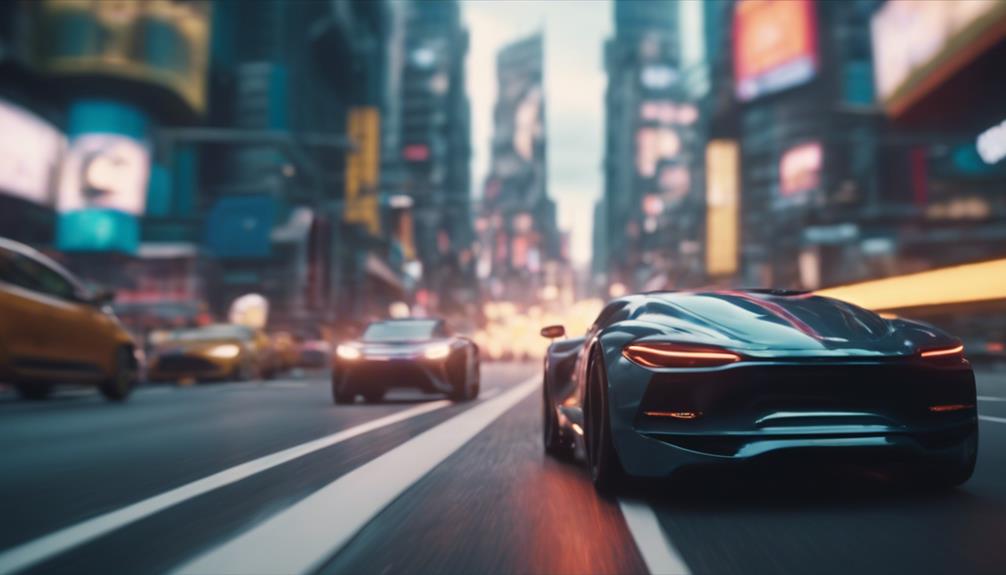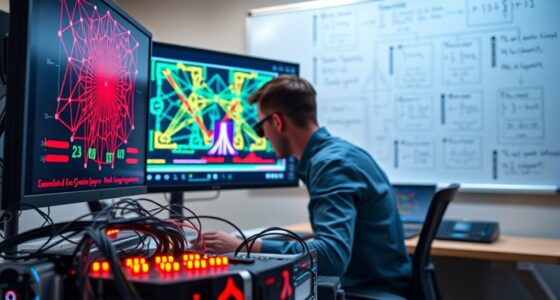AI, like Charles, learns to drive in the virtual world of GTA V and is starting to outperform human drivers in real-life scenarios. This open-source AI uses convolutional neural networks to interpret images and improve its driving skills. Although still in its early stages, Charles is gradually overcoming initial challenges like traffic rule violations. Future improvements aim to integrate short-term memory for better adaptability and decision-making. As it learns from simulations, AI's enhanced performance could greatly boost road safety and efficiency. Want to find out how this could reshape transportation? Keep going for the latest insights!
Key Takeaways
- AI Charles utilizes advanced convolutional neural networks to interpret visual data for driving, enhancing decision-making capabilities in simulated environments like GTA V.
- Continuous feedback loops allow Charles to learn from mistakes, gradually improving its driving skills and reducing collision rates over time.
- Integration of short-term memory is planned to enhance adaptability, enabling the AI to respond more effectively to dynamic real-world driving scenarios.
- AI training in gaming environments provides synthetic data, improving learning efficiency and preparing AI for real-world applications in autonomous driving.
Overview of Charles
Charles, an open-source AI designed as a convolutional neural network, learns to drive in Grand Theft Auto V by interpreting single-frame images and pixel data from its environment. This AI operates by analyzing its surroundings, making driving decisions based on the visual input it receives.
While Charles is currently in the learner's permit stage, it showcases basic driving skills, though it often struggles with traffic rules and navigational accuracy. As you watch Charles in action, you can see the challenges it faces, such as running red lights or misjudging turns. These errors highlight the learning curve inherent in AI development.
Streaming on Twitch by user sentx, you can engage with real-time updates, witnessing Charles's progress firsthand. This interactive experience allows you to follow how the AI adapts and evolves its driving abilities.
In the future, enhancements aim to incorporate short-term memory into Charles's design, which could greatly boost its adaptability and performance. The journey of this AI not only illustrates the potential of technology in gaming but also raises intriguing questions about the future of autonomous driving.
Learning Mechanism

When you think about Charles's learning mechanism, you'll notice it heavily relies on visual input processing to make driving decisions.
However, without short-term memory, it struggles to remember past frames, which affects its overall performance.
Error correction mechanisms play an essential role in helping Charles improve its skills over time, but there's still room for enhancement.
Visual Input Processing
Visual input processing in AI driving relies on convolutional neural networks to interpret complex screen visuals, enabling effective decision-making based on pixel data.
This method allows Charles, the AI developed for driving in GTA V, to analyze single frame images and understand the visual context of its environment. By doing so, it adapts to traffic rules and navigates the game world more effectively.
You'll notice that during its initial learning phase, Charles encounters accidents and errors, as its driving skills are still basic. The AI requires extensive training to refine its navigational abilities, learning from each mistake along the way.
The current design of the visual input processing mechanism is meant to improve over time, incorporating more complex algorithms for better decision-making in driving scenarios.
However, it's significant to mention that Charles currently lacks short-term memory. This limitation affects its ability to retain information between frames, which can hinder its overall learning efficiency.
As the AI evolves, enhancing its visual input processing capabilities will be vital for achieving even greater driving performance and safety in real-world applications.
Short-Term Memory Integration
Integrating short-term memory into Charles' learning mechanism will greatly enhance its ability to adapt and respond to real-time driving challenges. Currently, Charles lacks this essential feature, which limits its capacity to retain information from previous frames. This deficiency affects its performance in dynamic environments where quick decision-making is fundamental.
By incorporating short-term memory, Charles can learn from past mistakes, allowing it to adjust its behavior more effectively on the road. This advancement will enable the AI to better mimic human drivers, who naturally remember recent actions and modify their strategies accordingly.
Imagine how much smoother and safer driving could become when Charles can recall and integrate recent experiences into its decision-making process. The integration of short-term memory is vital for developing an AI capable of maneuvering the complexities of real-world driving situations.
With this enhancement, Charles won't only improve its adaptability but also its overall performance, making it a more reliable driver. Ultimately, the ability to utilize short-term memory will mark a significant leap forward in AI driving technology, paving the way for safer and more efficient driving experiences.
Error Correction Mechanisms
Charles employs error correction mechanisms that analyze single frame images and pixel data to refine its driving performance. When it encounters accidents or navigational errors, these mechanisms help it adapt by processing the visual input from its environment.
You'll notice that as Charles experiences these challenges, it gradually improves, learning from its mistakes without the benefit of short-term memory. This limitation means it can't retain lessons from past errors in real-time driving scenarios, but it still manages to enhance its behaviors over time.
The continuous feedback loops in the learning algorithm play a significant role in this process. Each time Charles makes a mistake, the error correction mechanisms kick in, allowing it to adjust its decisions and strategies accordingly. This iterative process drives Charles toward more effective driving techniques, even if it can't remember each incident.
Future enhancements are set to integrate short-term memory into the AI, which will enable it to remember and learn from previous errors and successes more effectively. With these innovations, you can expect even greater improvements in its driving capabilities.
Performance and Challenges

When you observe Charles' driving, you can see the initial errors it makes while trying to navigate traffic.
Over time, you might notice some gradual skill improvement, but it still faces significant challenges.
Learning through simulations is key, yet the path to mastering fluid driving remains a work in progress.
Initial Driving Errors
In its early stages, the AI faced numerous challenges, frequently breaking traffic rules and struggling to grasp the complexities of driving regulations.
You'd notice that initial driving errors were common, with the AI often ignoring stop signs and speeding through red lights. The performance of the AI tools used was basic and rudimentary, leading to a series of accidents and misjudgments as it adapted to the virtual environment.
While there were moments when the AI, named Charles, managed to navigate a few blocks without collisions, these instances were few and far between.
Despite slight improvements noted by long-term viewers, Charles remained far from being a safe or effective self-driving system. You could see that the AI's decision-making process was still developing, causing it to misinterpret road signs and fail to yield to pedestrians.
Gradual Skill Improvement
Over time, viewers have witnessed Charles making noticeable strides in its driving skills, steering through the virtual streets with more confidence and fewer errors. This gradual skill improvement highlights the potential of automated driving technology, though challenges remain.
| Skill Aspect | Initial Performance | Current Performance |
|---|---|---|
| Traffic Rule Adherence | Frequent violations | Improved adherence |
| Collision Rate | High | Lower |
| Navigation Ability | Basic | More effective |
While Charles has adapted to in-game traffic rules and physics, it still struggles with certain scenarios. The AI can occasionally navigate short distances without collisions, showcasing its progress. However, it is vital to recognize that Charles is still far from being a safe or effective self-driving system.
To enhance its learning, developers plan to introduce short-term memory features. This addition aims to refine Charles's driving capabilities further. As automated driving technology evolves, understanding these gradual improvements and ongoing challenges remains significant for future advancements.
Learning Through Simulations
Learning through simulations allows Charles to adapt its driving skills by interpreting pixel data, yet challenges remain as it grapples with real-world complexities. While the AI excels in the controlled environment of Grand Theft Auto V, it struggles with the nuances of actual driving situations. The hyper-realistic gaming scenarios provide a safe space for training, but converting this learning to real life isn't straightforward.
- Short-term memory limitations hinder Charles' ability to react dynamically during unexpected situations.
- Real-world unpredictability introduces variables that simulations often overlook, like weather conditions and erratic human behavior.
As Charles navigates the virtual landscape, its gradual improvement shows promise. Still, the shift from pixels to pavement will require significant advancements in AI technology. Overcoming these hurdles is essential for Charles to become a truly competent driver beyond the confines of a game.
Technical Aspects

Charles, the AI driving system for GTA V, leverages convolutional neural networks to interpret single frame images and make real-time decisions. This technology allows the AI to analyze pixel data effectively, enabling it to learn traffic rules and respond to various scenarios within the game environment. Written in Python, Charles benefits from an open-source structure that encourages flexibility and community input, enhancing its capabilities over time.
The core of Charles's artificial intelligence lies in its learning algorithm, which focuses on visual recognition and response. Although its current performance is still rudimentary—with frequent errors and accidents—it shows steady improvement as it adapts to the game's complex environment.
Future iterations plan to incorporate short-term memory, which will enhance decision-making capabilities and further refine its driving skills.
Community Engagement

Watching Charles's driving progress on Twitch not only showcases real-time AI learning but also invites you to engage actively in the development process. This unique approach allows you to witness firsthand how the AI improves its driving skills in GTA V while contributing to a larger community effort. As an audience member, you're no longer just a spectator; you're part of a collaborative journey that enhances the project.
You can provide feedback on Charles's driving decisions, influencing the learning curve and outcomes.
Community contributions to the open-source project create opportunities for shared achievements, fostering a collective sense of purpose.
Engaging in discussions around the ethical implications and safety of AI in gaming enriches the overall experience, making you a more informed participant.
This shift from passive consumption to active involvement reflects a growing trend in gaming, where community engagement drives the evolution of AI technology.
Real-World Implications

AI systems trained in gaming environments, like those in GTA V, are poised to transform real-world driving by enhancing the safety and efficiency of autonomous vehicles on our roads. These advanced systems demonstrate driving capabilities that can surpass human performance, especially in controlled environments. By utilizing video games for training, AI learns to navigate diverse traffic scenarios, preparing it for the complexities of real-world driving.
The synthetic data generated from these gaming environments proves to be as effective, if not superior, to real-world data, markedly improving the AI's learning efficiency. This means that self-driving cars can adapt more quickly to unexpected obstacles and dynamic traffic conditions.
As AI continues to enhance its driving performance, we can anticipate a revolution in the transportation industry. Reliable and efficient traffic management systems could emerge, ultimately leading to safer roads for everyone.
However, these advancements raise critical discussions regarding regulations and safety protocols necessary for integrating autonomous technology into everyday driving. The implications are vast, suggesting a future where self-driving cars not only coexist with human drivers but also markedly improve overall road safety and efficiency.
Future Prospects

The future of autonomous driving looks promising, as advancements in complex algorithms and short-term memory are set to greatly enhance vehicle performance. Imagine a world where AI-driven cars not only learn from virtual environments like GTA V but also adapt seamlessly to real-world challenges. This evolution could redefine your daily commute and urban living.
AI systems may outperform human drivers in reaction times and adherence to traffic rules. Enhanced safety features could considerably reduce accidents and save lives. Urban planning may shift to accommodate AI-driven vehicles, leading to more efficient transportation systems.
As AI learns from unpredictable traffic scenarios, it'll become more adept at steering through complex environments. The integration of gaming simulations into AI training represents a considerable leap forward, allowing for safe, controlled learning experiences.
This blend of gaming and real-world application sets the stage for smarter, safer roads. Your future rides could be more relaxing, knowing AI is steering the way, potentially transforming how we think about transportation altogether. The exciting prospects of AI in driving technology are just beginning to unfold, promising a safer, more efficient future for everyone on the road.
Frequently Asked Questions
Is GTA Good for Learning to Drive?
GTA can be a fun way to practice driving skills in a virtual environment. You'll experience various scenarios and traffic patterns, but remember, it's not a replacement for real-world driving lessons and techniques.
How Is AI Impacting Driverless Cars?
Like a skilled painter, AI's transforming the canvas of driving. It's enhancing driverless cars by processing vast data, improving safety, and adapting to real-world conditions, making the roads safer for everyone. You'll see the difference!
Will Self-Driving Cars Ever Become a Viable Alternative to Humans Operating Them?
Self-driving cars could become a viable alternative to human drivers, especially with advancements in technology. However, regulatory challenges, public acceptance, and safety concerns need addressing before they can truly replace human operation on the roads.
How Do Self-Driving Cars Drive Better Than Humans?
Isn't it ironic? While you might get distracted by a text, self-driving cars stay focused. They process data faster, never tire, and learn from countless miles, making them safer and more efficient than human drivers.
Conclusion
In the race between man and machine, it's clear that AI's journey through GTA has paved the way for real-world driving excellence.
As the saying goes, 'Where there's a will, there's a way.'
You've witnessed how AI learns, adapts, and outperforms human drivers, pushing the boundaries of technology.
As we embrace these innovations, consider the possibilities ahead.
The road to the future is wide open, and the AI-driven vehicles are ready to take the lead.









